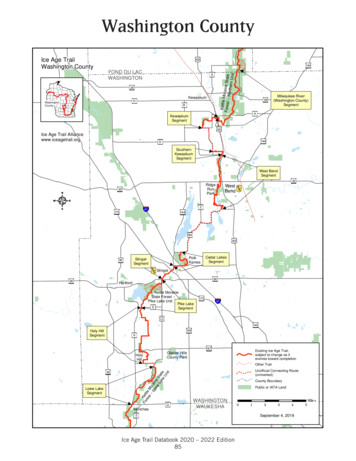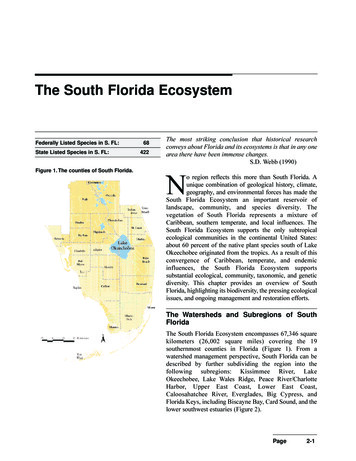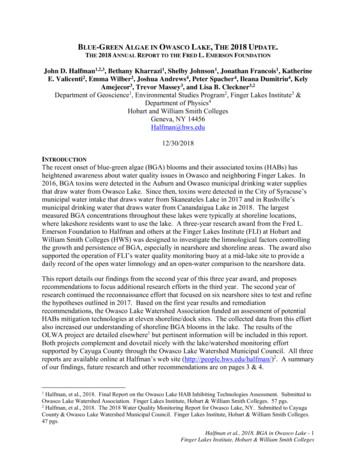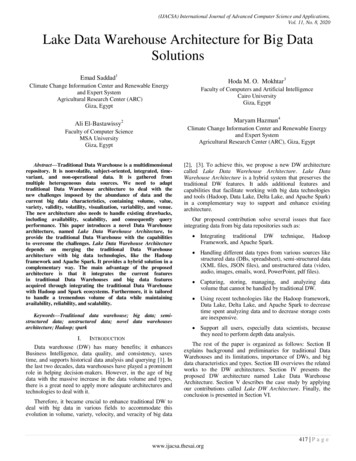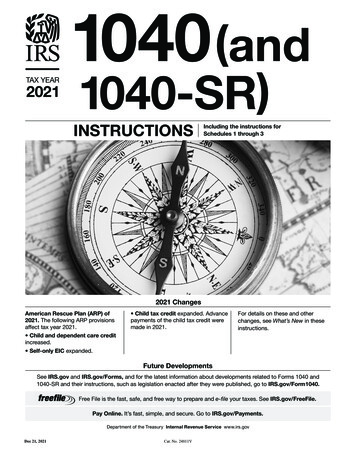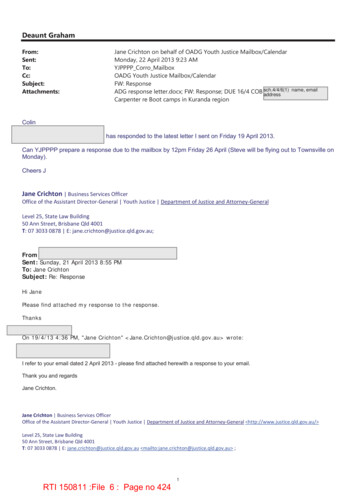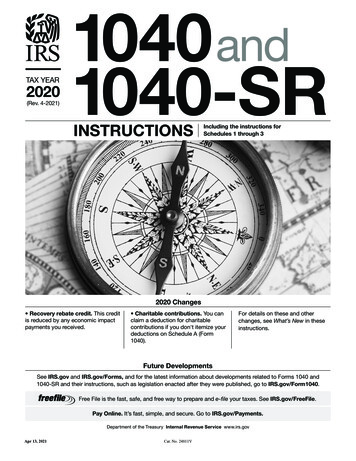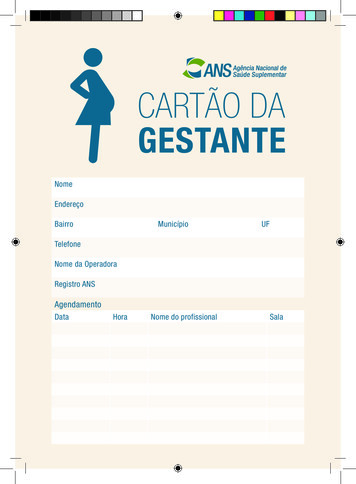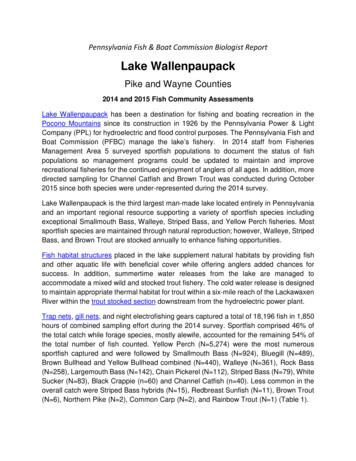
Transcription
Pennsylvania Fish & Boat Commission Biologist ReportLake WallenpaupackPike and Wayne Counties2014 and 2015 Fish Community AssessmentsLake Wallenpaupack has been a destination for fishing and boating recreation in thePocono Mountains since its construction in 1926 by the Pennsylvania Power & LightCompany (PPL) for hydroelectric and flood control purposes. The Pennsylvania Fish andBoat Commission (PFBC) manage the lake’s fishery. In 2014 staff from FisheriesManagement Area 5 surveyed sportfish populations to document the status of fishpopulations so management programs could be updated to maintain and improverecreational fisheries for the continued enjoyment of anglers of all ages. In addition, moredirected sampling for Channel Catfish and Brown Trout was conducted during October2015 since both species were under-represented during the 2014 survey.Lake Wallenpaupack is the third largest man-made lake located entirely in Pennsylvaniaand an important regional resource supporting a variety of sportfish species includingexceptional Smallmouth Bass, Walleye, Striped Bass, and Yellow Perch fisheries. Mostsportfish species are maintained through natural reproduction; however, Walleye, StripedBass, and Brown Trout are stocked annually to enhance fishing opportunities.Fish habitat structures placed in the lake supplement natural habitats by providing fishand other aquatic life with beneficial cover while offering anglers added chances forsuccess. In addition, summertime water releases from the lake are managed toaccommodate a mixed wild and stocked trout fishery. The cold water release is designedto maintain appropriate thermal habitat for trout within a six-mile reach of the LackawaxenRiver within the trout stocked section downstream from the hydroelectric power plant.Trap nets, gill nets, and night electrofishing gears captured a total of 18,196 fish in 1,850hours of combined sampling effort during the 2014 survey. Sportfish comprised 46% ofthe total catch while forage species, mostly alewife, accounted for the remaining 54% ofthe total number of fish counted. Yellow Perch (N 5,274) were the most numeroussportfish captured and were followed by Smallmouth Bass (N 924), Bluegill (N 489),Brown Bullhead and Yellow Bullhead combined (N 440), Walleye (N 361), Rock Bass(N 258), Largemouth Bass (N 142), Chain Pickerel (N 112), Striped Bass (N 79), WhiteSucker (N 83), Black Crappie (n 60) and Channel Catfish (n 40). Less common in theoverall catch were Striped Bass hybrids (N 15), Redbreast Sunfish (N 11), Brown Trout(N 6), Northern Pike (N 2), Common Carp (N 2), and Rainbow Trout (N 1) (Table 1).
Table 1. Species captured, number caught, and size ranges for measured speciescollected during the 2014 Lake Wallenpaupack survey.NumberLength Rangecaught(Inches)Sportfish Species (46% of Total Catch)Bass – riped Hybrid1524-28Brown Trout – hatchery47-26Brown Trout – wild28-9Rainbow Trout-Hatchery19Common carp224-26PanfishBlack crappie604-14Bullhead – Brown4048-17Yellow368-13Bluegill4892-10Channel catfish4017-35Perch – Yellow5,2473-14Pumpkinseed1452-9Redbreast Sunfish112-8Rock bass2583-12Sunfish hybrid18White sucker8310-23PikeChain pickerel1127-26Northern Pike225-30Walleye36110-30Forage Species (54% of Total Catch)Alewife9,7293-6Bluntnose minnow2not measuredCommon Shiner22-3Fallfish64-15Golden Shiner125-11Margined Madtom22-5Spotfin shiner2not measuredSpottail shiner234-5SpeciesComments42% 12”33% 12”67% 20”100% 20”72% 9”87% 12”28% 12”74% 7”88% 24”55% 9”26% 7”18% 7”26% 8”49% 18”67% 15”
Lake Wallenpaupack’s “black bass” population continues to provide exceptional anglingopportunities supported through natural reproduction and management underCommonwealth Inland Water Regulations. Smallmouth Bass (N 924) outnumberedLargemouth Bass (N 142) by more than 6:1 and continue to be the dominant “black bass”species in the lake (Table 1 and Figure 1). The longest Smallmouth Bass and LargemouthBass were 19 and 21 inches, respectively. Overall, night electrofishing catch rates werehigher than previous survey results for total catch and catch 12 inches for both species(Table 2 and Figure 2). Catch rates for bass 15 inches were consistent with historicsurvey results, which yield from four to five Smallmouth Bass and from one to threeLargemouth Bass per hour of night electrofishing. Survey crews observed bass beingcaught frequently by anglers over the course of the survey, suggesting very good catchrates by anglers.Figure 1. Length frequency distributions of Smallmouth Bass and Largemouth Bassfrom the 2014 survey.
Table 2. Comparison of mean night electrofishing catch rates for Smallmouth Bass(SMB), Largemouth Bass (LMB), and SMB and LMB Combined. (CPH Catch Per Hour).SMB1998LMB CombinedYear surveyed2000SMB LMB CombinedSMB2014LMB CombinedCPH34.50 1.6336.1343.23 3.5746.8061.19 10.7171.90CPH 12”11.80 1.5413.3413.05 2.1415.1915.024.3019.32CPH 15”5.416.794.075.693.922.506.421.381.62Figure 2. Comparison of June night electrofishing catch rates for Smallmouth Bassand Largemouth Bass combined.Walleye management at Lake Wallenpaupack is focused on maintaining the populationas a quality fishery and as an important brood fish source for PFBC hatchery production.Nearly all captured Walleye (98%) were legal size measuring 15 inches in total length(Table 1 and Figure 3). The longest Walleye captured was 30 inches and weighed over
12 pounds! April catch rates for gillnets and trapnet varied inversely making it unclear ifthe population was more or less abundant than when previously assessed (Figures 4 and5). For example, gillnet catch rates were greater than historic results, four times higherthan the guideline of 0.3 fish per gillnet hour, and presumably reflected high spawningactivity in the western portion of the basin where “ice out” occurs first. In contrast, trapnetcatch rates were slightly lower than previous survey results, less than the guideline of0.15 fish per trapnet hour, and appeared to reflect the post spawn period when adultsdisperse from near shore areas and become less vulnerable to being caught in trapnetsset near shore in shallower water. Also, an abundance of Yellow Perch in April trapnetssignaled an end to Walleye spawning since they are one of the first species to spawnafter winter and occasionally do so before “ice-out” and before Yellow Perch. Delays insetting nets at several “good” trap net sites, due to ice cover in early April likely meant theopportune time to sample adult Walleye had passed as a result of the severe andprolonged winter of 2013/2014. Despite disparity between catch rates both gearsrevealed an abundance of legal and trophy size Walleye as present. Fingerling plants arescheduled to continue on an annual basis to maintain the fishery for anglers and PFBCbrood collection. Since there is a one meal per month fish consumption advisory anglersare reminded to minimize their exposure to reduce health risks associated withcontaminants in fish they harvest for consumption.Figure 3. Length frequency distribution of Walleye catch.
Figure 4. Comparisons of April gillnet catch rates for Walleye.Figure 5. Comparisons of April trapnet catch rates for Walleye.
Walleye tagged for 2014 Cast for Cash fishing contestAnnual fingerling Striped Bass stockings continue to build a high quality landlocked“striper” fishery; while periodic plants of hybrid Striped Bass (i.e., White bass X StripedBass, “hybrids”) supplement the fishery. Sixty-seven percent (n 53) of the Striped Basscatch was legal length of 20 inches (Table 1 and Figure 6). The longest Striped Basscaptured was 37 inches and weighed over 19 pounds. Stocked fingerling survival andrecruitment has been favorable as evidenced by the broad range of legal and sub-legallength fish collected (Figure 6). Fingerling plants are scheduled to continue on an annualbasis to maintain and further develop the “striper” fishery. In addition, stocked fingerlingstypically reach legal length by the end of their fourth growing season based on age andgrowth analysis of scales removed from captured fish.
Figure 6. Length frequency distributions of Striped Bass and Striped Bass hybrid.Striped bass (left) with inset of 1-2” fingerlings and hybrid (right). Both adult fish areillustrated with blue floy tags inserted at base of spiny portion of dorsal fin, which wascarried out in conjunction with the 2014 Cast for Cash fishing contest.Lake Wallenpaupack’s Yellow Perch population continues to provide an attractive panfishfishery supported through natural reproduction and recruitment of individuals to preferredsize. Yellow Perch ranged from 3 to 14 inches in total lengths with 55% of the catch 9inches (Table 1 and Figure 7). April trapnet catch rates were higher than previous surveyresults for total catch, catch 9 inches, and catch 12 inches, reflecting an abundanceof catchable fish for anglers interested in this year-round panfish favorite (Figure 8).Comparison of length frequency distributions shows similar population structure with 9inch fish most common among assessments (Figure 9). The abundance of 9-inch YellowPerch suggests a very strong year-class was present to influence population abundanceand size structure of the stock, which may provide better than average fishing over severalseasons.
Figure 7. Length frequency distribution of Yellow Perch catch.Figure 8. Comparisons of trapnet catch rates for Yellow Perch during April.
Figure 9. Comparisons of Yellow Perch length frequency distributions from April trapnetcatches.Yellow Perch (female with eggs) tagged for 2014 Cast for Cash fishing contest.
Bluegills were the most numerous sunfish captured, excluding black bass, and werefollowed by Rock Bass, Pumpkinseed, and Black Crappie in numbers handled (Figure10). Collectively, these species provide both novice and experienced anglers withworthwhile near shore fishing opportunities supported by natural reproduction andconsistent recruitment of individuals to preferred sizes. The percent of Bluegill (74%) andRock Bass (56%) 7 inches and Black Crappie 9 inches (72%) characterize a qualityfishery with even larger and more preferable sizes of Bluegill, Rock Bass, and BlackCrappie present.Figure 10. Length frequency distributions for Bluegill, Rock Bass, Pumpkinseed, andBlack Crappie.
Yellow Perch and Bluegill (top) Rock Bass (middle) and three BlackCrappie (bottom) tagged for 2014 Cast for Cash fishing contestChain Pickerel compliment the lake’s fishery with nearly half (49%) of the catch 18inches in total length, the minimum legal length for harvest (Figure 11). The largest ChainPickerel captured was 26 inches long and weighed nearly five pounds. The lengthfrequency distribution exhibits a wide range of uninterrupted sizes present; whichindicates regular stable natural production and recruitment to the population. Theabsence of fish 7 inches was due in part to gear and sampling selectivity targeting largerfish in the population. Although Chain Pickerel are often considered an unintended catchby some anglers pursuing other sportfish they are exciting to catch because of theiraggressive nature when hooked. They are also one of the few species active throughwinter under the ice, and provide special enjoyment when caught by ice anglers. Inaddition, the catch of two Northern Pike 24 inches (legal size), a species similar to ChainPickerel but with greater size potential, confirmed their continued presence at low densityin the lake (see photo below Figure 11).
Figure 11. Length frequency distribution of Chain Pickerel collected in the 2014 sample.Legal ( 24 inch) length Northern PikeChannel Catfish were successfully introduced into Lake Wallenpaupack in the late 1980’sto diversify the fishery, promote the occasional catch of a trophy fish, and develop atargeted fishery. Annual fingerling plants occurred from 1995-2000, and werediscontinued in 2001 to allow natural reproduction to economically sustaining thepopulation following establishment of the requisite spawning stock. The catch of 40Channel Catfish ranging from 17 to 35 inches, with 88% of the catch 24 inches, suggestsgood survival of this long-lived species from past stockings; which contributed to ourexpectation that natural reproduction would serve to maintain the fishery (Table 12).Catch rates were highest for June night electrofishing (Mean 1.02 fish/hr) and lowest for
both April and June trapnets (Mean 0.01 fish/hr). Gillnet catch rate for April (Mean 0.15fish/hr) and May (Mean 0.29 fish/hr) met the minimum statewide objective of 0.04 fish/hr.established to characterize desirable and targeted Channel Catfish fisheries in largereservoirs.Channel catfish spawning activity was observed during June night electrofishing whenseveral pairs of adults were observed utilizing natural rock crevices as nesting habitat.This behavior indicates reproductive activity and suggests that successful reproductionand recruitment may be sufficient to maintain the population at its current level. Additionalsampling during October 2015 resulted in a disappointing catch of just two large adults(31 and 33 inches long) in 15 scent baited hoop net sets. These results suggest thatmonitoring may be in order to ensure that abundance levels; whether sustained by naturalrecruitment or stocking are sufficient to maintain angler success and satisfaction.However, prior to any return to stocking, additional sampling with scent baited hoop netswill occur during the summer seasons of either 2016 or 2017 when warmer temperaturespromote greater fish activity and dispersal of the bait’s scent to lure channel catfish intohoop nets.Figure 12. Length frequency distribution of Channel Catfish collected in the 2015sample.
Channel catfish tagged for 2014 Cast for Cash fishing contestFour hatchery Brown Trout were captured during the 2014 survey, despite annual plantsof 125,000 fingerlings. The total catch of three adults (20, 21, and 25 inches) and onejuvenile (7 inches) was the lowest to date; which covers surveys from 1980 (N 10), 1985(N 39), 1992 (N 12), and 1998 (N 9). Additional sampling directed specifically to troutduring October 2015 resulted in none being captured. Our low catch combined withknowledge from anglers, solicited during the survey, suggests that a modest fishery fortrophy fish during spring and fall continues to exist as supported by fingerling troutstockings. Based on the findings of this survey the annual allocation of fingerling BrownTrout has been decreased to 62,500. Area 5 staff plans to continue to address this issuewith additional sampling to occur in 2016 and 2017 as well.Thermal depth profiles conducted in July, 2014 suggest that there may not be a sufficientcold or cooler region to hold trout in great numbers. The profiles suggest variable “habitatsqueezes” throughout the lake during summer and early fall when lake stratificationreduces the amount and quality of preferred coldwater habitat (Figure 13). Generallywhen lake surface temperature rise above 68o Fahrenheit (20o Celsius) trout seek refugein colder water at deeper depths having dissolved oxygen concentrations 5mg/l. Waterquality measurements during summer show the thermocline becoming establishedsomewhere around 6.5 meters (21 ft.) through much of the lake, except in the shallowerLedgedale Area where it becomes poorly defined near the bottom at around 4 meters (13ft.). The onset and duration of stressful conditions for trout during summer and early fallsuggests that the reservoir’s capacity to consistently support enough coldwater habitatbecomes variable for trout from year to year. Also, heavy predation by other species onstocked fingerlings and young adults may be additional factors lending to low survival andrecruitment, thus further limiting the fishery along with seasonal changes in coldwaterhabitat availability and the development of other competing sportfish fisheries.
25 inch, 7.8 pound Brown Trout
Figure 13. Lake Wallenpaupack vertical profiles of water temperature and dissolvedoxygen recorded at five locations extending from the upper lake(Ledgedale Area) to the lower lake (Dam Area) during summer 2014.Fisheries Management Area 5 (Bushkill)
Lake Wallenpaupack is the third largest man-made lake located entirely in Pennsylvania and an important regional resource a variety of sportfish supporting species including exceptional Smallmouth Bass, Walleye, Striped Bass, and Yellow Perch fisheries. . the total catch while forage specie

